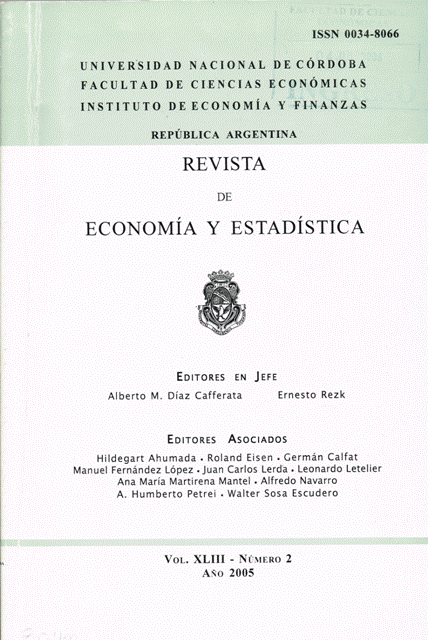El modelo de expectativas adaptativas como mejor método para estimar la variable precio del grano en el modelo de equilibrio parcial para girasol
DOI:
https://doi.org/10.55444/2451.7321.2005.v43.n2.3819Keywords:
girasol, modelo de equilibrio, ajuste parcial de precioAbstract
El objetivo de este trabajo es identificar el indicador apropiado para la variable precio del grano de girasol, ecuación que es parte del modelo de equilibrio parcial para girasol. Para elegir la variable proxy se estimaron dos modelos: el de expectativas adaptativas de Koyck y el de ajuste parcial o de ajuste de existencias y se calculó el precio promedio del grano considerando los mercados de Buenos Aires, Rosario y Bahía Blanca. Luego de aplicar los diferentes modelos para los precios "esperados" se estimó el modelo de equilibrio parcial a partir de "mínimos cuadrados en dos (MC2E) y en tres etapas (MC3E)". Mediante el test de Hausman (Judge et al, 1988) se estableció el método de estimación apropiado. Entre los resultados se destaca que los mejores indicadores fueron el "precio promedio" y el "precio esperado" calculado por el método de expectativas adaptativas. Así, se deduce que el precio que el productor "espera" es una ponderación de lo ocurrido en los últimos ocho meses (precio en el momento de la siembra y el que recibió en la cosecha anterior). Contrariamente, no se encontró en el método de "ajuste parcial" un buen estimador de precio.
Downloads
Downloads
Published
Issue
Section
License
Copyright (c) 2005 Sonia Calvo, Alfredo A. Visintini, Walter Robledo

This work is licensed under a Creative Commons Attribution-NonCommercial-NoDerivatives 4.0 International License.
Authors who have publications with this journal agree to the following terms:
Authors retain their copyright and grant the journal the right of first publication of their work, which is simultaneously subject to the Creative Commons Attribution-NonCommercial-NoDerivatives 4.0 International License that allows third parties to share the work provided that its author and first publication in this journal are indicated.
Authors may adopt other non-exclusive licensing arrangements for distribution of the published version of the work (e.g. depositing it in an institutional telematic archive or publishing it in a monographic volume) as long as the initial publication in this journal is indicated.
Authors are allowed and encouraged to disseminate their work via the Internet (e.g. in institutional telematic archives or on their website) before and during the submission process, which can lead to interesting exchanges and increase citations of the published work. (See The Open Access Effect)










